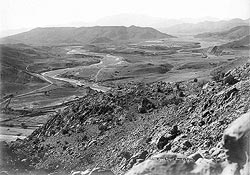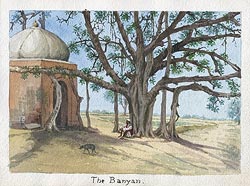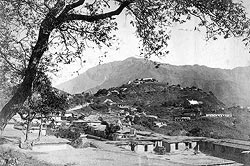The North-West Frontier of India
The Great Game
 |
| From Haigh Piquet towards Sarwaki (Click to enlarge) |
When 1st Queen’s returned to India in 1895 they were based at Ambala but the Battalion was frequently away, engaged against the tribes on the North-West Frontier. For many years suspicion had persisted in India that Russia would attempt to invade India from Afghanistan. Russia dominated the approaches to the country from the west and could not be allowed to extend its influence in the capital, Kabul, in order to develop the infrastructure required for a military invasion of India across tribal territory. Afghan and Pathan tribesmen were fiercely independent, warriors first and last, skilled in ambush, exceptionally courageous and hardy, able to assemble in a few hours and disperse as quickly.
 |
| The Banyan Tree (Click to enlarge) |
There was no international frontier with the Punjab until 1894 when the Durand Line was demarcated across tribal territory. Within it the tribesmen were deemed to be protected persons subject to British law. There were police, roads and schools, and revenues were collected. British political officers maintained contact with the tribesmen who were subsidized as long as their conduct remained within bounds. When it did not, military operations were mounted to restore order and apply punishment. Politically it was a sterile situation. Militarily it came to be called romantically the Great Game. But for British and Indian soldiers there was little romance and much demand for a high degree of courage, skill and physical fitness against a formidable enemy.
In 1897-98 1st Queen’s took part in two major operations which came to be known as the Mohmand and Tirah Campaigns.
| 1st Bn The Queen’s Royal Regiment, Peshawar 1905. (Click to enlarge) |
View of Solon, 1890. (Click to enlarge) |
Related


